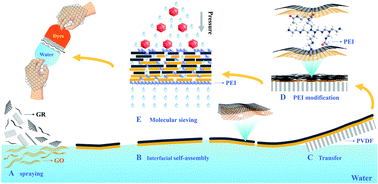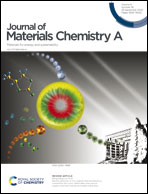Interfacial self-assembled GR/GO ultrathin membranes on a large scale for molecular sieving†
Abstract
Graphene oxide (GO) has superior molecular sieving abilities due to its unimpeded two-dimensional (2D) nano-channels and nacre-like lamellar structure. However, it remains a huge challenge to fully exploit its unmatched features to construct a GO-based membrane on a large scale for excellent screening performance. Here, we display a facile, ultrafast and environmentally friendly strategy to design an ultrathin (graphene/graphene oxide@polyetherimide) GR/GO@PEI composite membrane under the collective effects of a hydrophilic PEI molecular-bridge and an ordered GR/GO laminar structure. Excitingly, this composite membrane presents extraordinary structural stability, even when transferred to any given substrate, regardless of its chemical components, structure, or specification. Furthermore, this membrane shows high permeance of up to 191 L m−2 h−1 bar−1 and over 99% rejection of Congo red, far superior to the majority of GO-based separation membranes reported so far. In addition, it can withstand several types of physical damage and chemical corrosion, as well as being further able to realize the purification of actual, complex, multi-component, domestic sewage. This work will open the door to developing scalable 2D lamellar membranes with ultrafast and precise separation channels for practical water purification.



 Please wait while we load your content...
Please wait while we load your content...